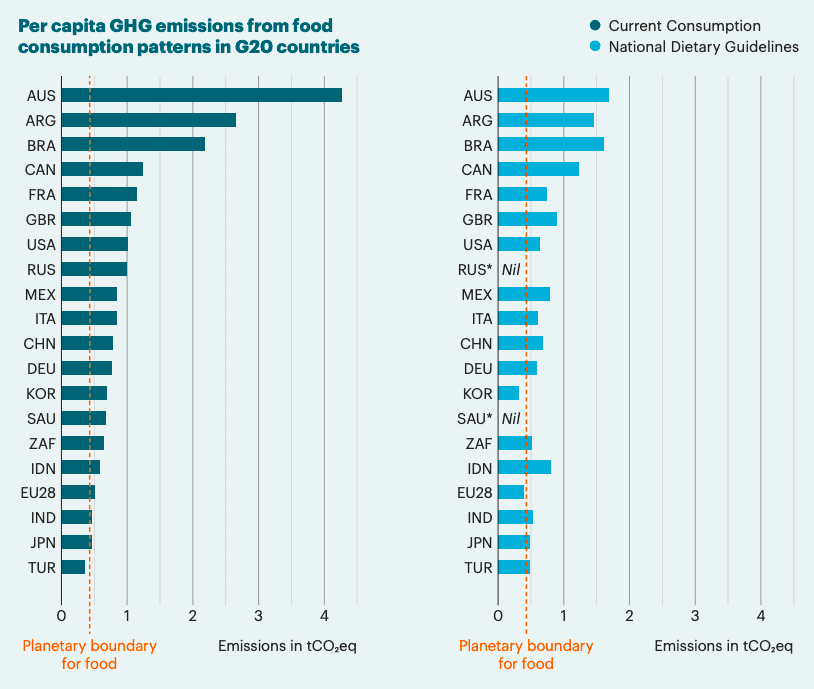Seven planets would be needed if everyone started eating like the world’s 20 leading economies, according to a report that compared the carbon emissions from food consumption in G20 countries.
The report urges us to rethink our diets amid climate change — especially as food consumption is a major driver of greenhouse gas emissions.

Among the G20 countries, only India and Indonesia have a diet low enough in carbon emissions to meet the targets of the Paris Agreement. Meanwhile, Argentina, Brazil, Canada, Germany, and the United States were the ones to exceed the most sustainable levels of food-related carbon emissions.
The Diets for a Better Future report, published by NGO EAT, focused on the national dietary guidelines and consumption rates of G20 countries. It showed that rich countries are consuming more red meat and dairy than is laid out in their countries’ nutritional guidelines, and much more than what is sustainable for the planet.
“Currently, individuals in a handful of countries are eating way too much of the wrong foods at the expense of the rest of the world,” Brent Loken, global food lead at WWF and lead author of the report, told AFP. “These imbalanced diets by a relative handful of rich countries are “to the detriment of climate, health and economies”.
Producing food for Earth’s 7.7 billion people is responsible for a quarter of the global carbon emissions that drive climate change. About 40% of that comes from livestock production and food waste, with the rest generated by rice production, fertilizer use, land conversion and deforestation to accommodate commercial crops. Calorie per calorie, meat produces far more emissions than other, equally nutritious foods.
The Paris climate agreement aims to keep global heating within two degrees Celsius. The so-called “food-print” emissions produced by G20 countries, which account for around 64% of the world’s population, currently create 75% of the total global food-related emissions, the report estimated.
“The report shows the food system has a long way to go in delivering diets that achieve health and wellbeing within planetary boundaries. Yet the good news is that there is a lot of governments, businesses and citizens can do now to make this happen, building on existing action to bring win-wins to all,” Corinna Hawkes, director of the University of London’s Centre for Food Policy, told Deutsche Welle.
Argentina is on top of the list of countries with a diet exceeding climate thresholds, followed by Canada, Brazil, the United States, Russia, and Australia. At the other end of the spectrum, the countries with the most climate-friendly dietary guidelines are Indonesia, India, South Korea, China, and Japan.

The report also identified that many countries even have national dietary guidelines of red meat and dairy that exceed health diet guidelines. Germany, for example, recommends 50 grams of red meat a day but the actual average consumption is around 110 grams.
Shifting toward healthier diets rich in legumes, vegetables, fruits and nuts, is useful for both the environment and our health, the authors argue. But considering that, for instance, almost all countries now fall short on food consumption of nuts and legumes, this is bound to be challenging.
Some, however, have already taken significant steps to promote healthier diets. Recently revised Chinese guidelines, for example, recommend to eat a variety of foods, with cereals as the staple; balance eating and exercise to maintain a healthy body weight; consume vegetables, milk, and soybeans; and consume an appropriate amount of fish, poultry, eggs, and lean meat.
A study released last year found that improving our nutrition can also be advantageous economically. Transitions in the way we grow and consume food could unleash $4.5 trillion in new business opportunities each year, at the same time-saving $5.7 trillion a year in health and environmental costs.
In addition, shifting diets can reduce the risk of future pandemics — which, especially given the current circumstances, could make a huge difference.






